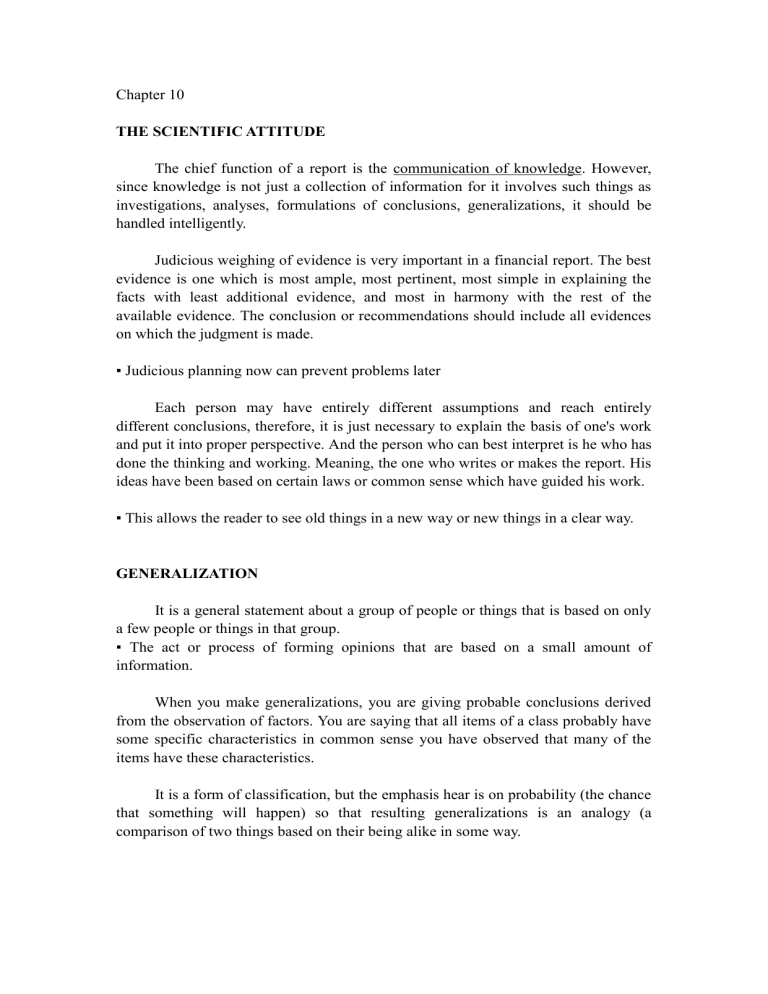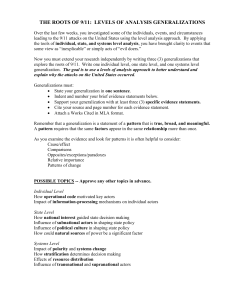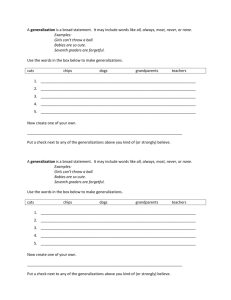
Chapter 10 THE SCIENTIFIC ATTITUDE The chief function of a report is the communication of knowledge. However, since knowledge is not just a collection of information for it involves such things as investigations, analyses, formulations of conclusions, generalizations, it should be handled intelligently. Judicious weighing of evidence is very important in a financial report. The best evidence is one which is most ample, most pertinent, most simple in explaining the facts with least additional evidence, and most in harmony with the rest of the available evidence. The conclusion or recommendations should include all evidences on which the judgment is made. ▪ Judicious planning now can prevent problems later Each person may have entirely different assumptions and reach entirely different conclusions, therefore, it is just necessary to explain the basis of one's work and put it into proper perspective. And the person who can best interpret is he who has done the thinking and working. Meaning, the one who writes or makes the report. His ideas have been based on certain laws or common sense which have guided his work. ▪ This allows the reader to see old things in a new way or new things in a clear way. GENERALIZATION It is a general statement about a group of people or things that is based on only a few people or things in that group. ▪ The act or process of forming opinions that are based on a small amount of information. When you make generalizations, you are giving probable conclusions derived from the observation of factors. You are saying that all items of a class probably have some specific characteristics in common sense you have observed that many of the items have these characteristics. It is a form of classification, but the emphasis hear is on probability (the chance that something will happen) so that resulting generalizations is an analogy (a comparison of two things based on their being alike in some way. TWO KINDS OF GENERALIZATIONS 1. Uniform generalization ▪ are concerned with whole classes ▪ They lead from specific cases to conclusions about all the members of the class or system. The larger the number of cases, the higher is the probability that the conclusion is reliable. Quality, however, as well as quantity must be considered to establish a valid generalization. Example: If you were inspecting a truckload of materials, you can safely judge the quality of the whole load from samples picked at random-front, middle, top, and bottom. 2. Statistical generalization ▪ deal with percentages of a class rather than with the class as a whole. ▪ they state that the percentage found in some samples represent the percentage probably found in the class as a whole. Example: Sixty-five percent of the school children in Balagtas High School go to school without breakfast. Since your report is based on generalizations, it is necessary to describe the circumstances surrounding your work. ▪ "My generalizations hold true for these conditions." Provide enough evidence, data, and samples, to enable the reader to evaluate the generalizations for himself. So that you can be certain that you have followed ground rules and are not "jumping to conclusions", test the validity of your data and samples. Here is a suggested checklist: 1. Can I prove its accuracy? ▪ freedom from mistake or error ▪ It must conform with the truth ▪ preciseness, each experiment is performed twice ti ensure accuracy. ▪ use exact fractions and decimal points on the terms and measurement. 2. Can I show the direct bond between fact and generalization? 3. Is it fact and not opinion? ▪ a true piece of information ▪ actual 4. Do I have all the facts? 5. Are they up-to-date? ▪ current, including the latest information newest in information 6. Is the generalization verifiable? ▪ would you get the same result if you did it again? ▪ to show the existence, truth or correctness of something by using evidence, logic, etc. 7. Is it significant? ▪ very important ▪ large enough to be noticed or have an effect


